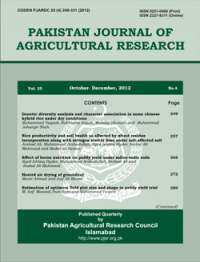RESPONSE OF DIFFERENT COTTON ( L.) GENOTYPES AT VARIOUS SALINITY LEVELS
Muhammad Bilal*, Zafar Abbas*, Ijaz Ahmad**, Muhammad Aslam*, Muhammad Ijaz****, Adnan Shakeel***, Mushtaq Ahmad*** and Kashif Bashir*****
ABSTRACT
Keeping in view the salt stress threat in Pakistan, a hypothesis was developed that up to what level of salt, the cotton genotypes can survive so that it may provide the shelter for income from textile industry, as mainly the textile industry depends upon cotton production. High salinity levels hamper the boll formation in cotton genotypes as it reduces the yield. To verify this fact, study was carried out under natural conditions as pots experiment in soil at water testing laboratory, D.G. Khan during 2012-13. Six cotton genotypes (FH – 945, FH – 901, NIAB – 111, NIAB – 999, B – 630 and B – 622) were collected from Nuclear Institute for Agriculture and Biology (NIAB) and Ayub Agricultural Research Institute (AARI), Faisalabad. The plant height of NIAB-111 was more affected by soil salinity than that of other varieties. The number of bolls per plant also showed the similar fashion to salinity stress for all varieties. Maximum average weight of cotton boll was recorded in control practice as compared to salinity gradient treatments. Sodium (Na ), Potassium (K ) and Chloride (Cl ) contents in leaf sap were present more in salinity gradient treatment cotton genotypes as compared to farmer practice. Overall, findings revealed that higher to lower salinity levels did not suit to tested varieties. At optimum salinity stress level, all varieties performed optimally under salt conditions.
To share on other social networks, click on any share button. What are these?






